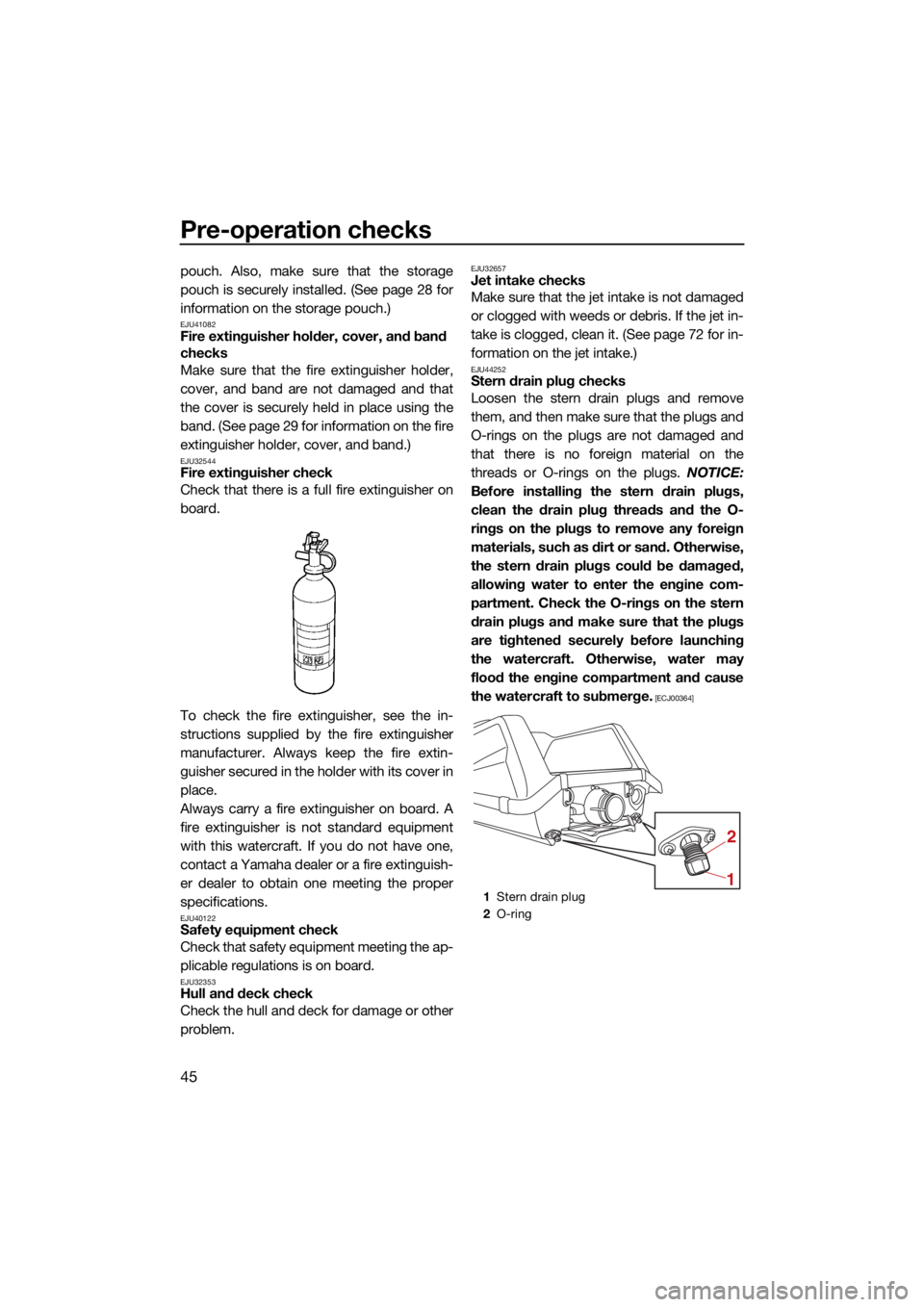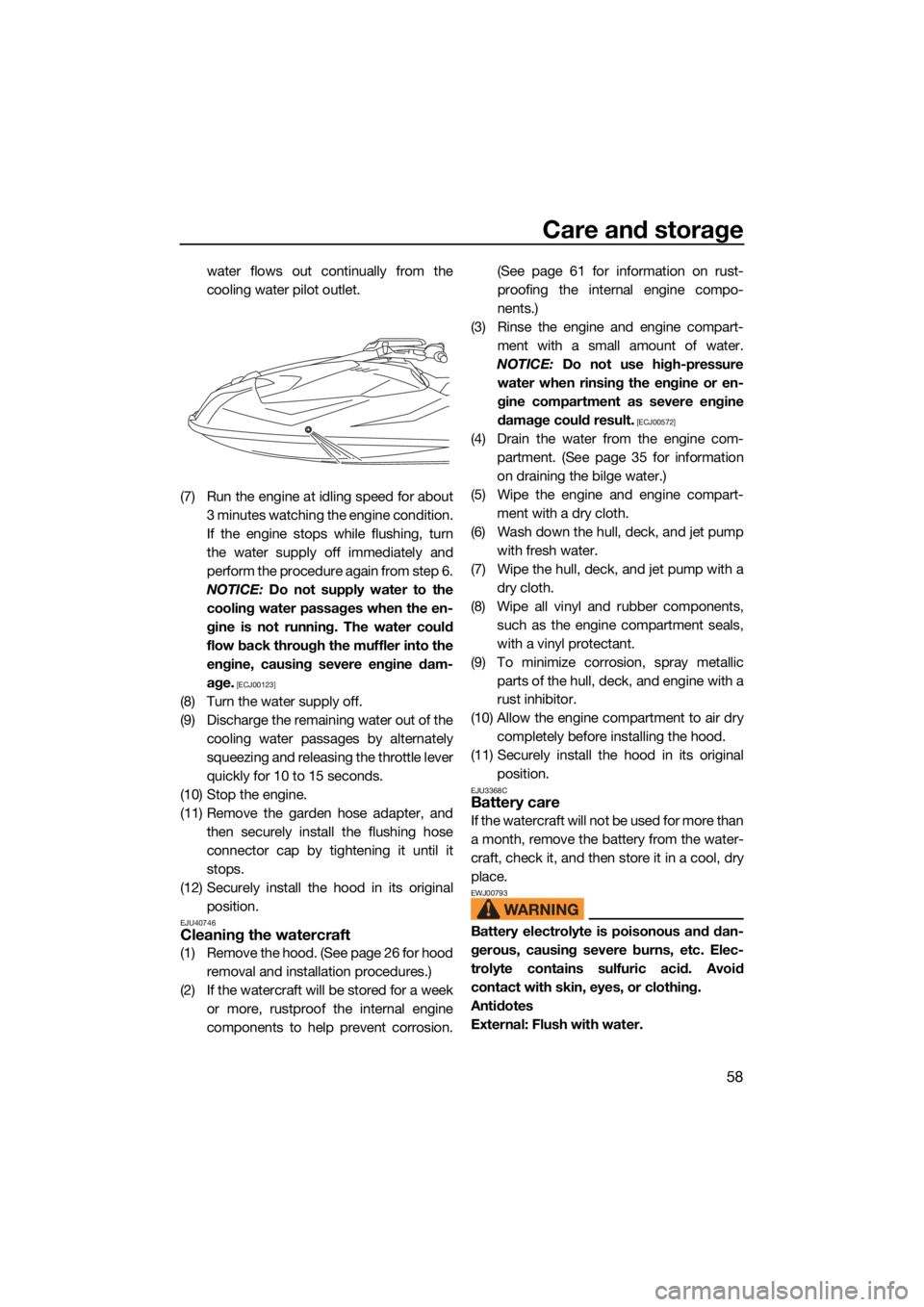ECU YAMAHA SUPERJET 2021 User Guide
[x] Cancel search | Manufacturer: YAMAHA, Model Year: 2021, Model line: SUPERJET, Model: YAMAHA SUPERJET 2021Pages: 84, PDF Size: 3.76 MB
Page 52 of 84

Pre-operation checks
45
pouch. Also, make sure that the storage
pouch is securely installed. (See page 28 for
information on the storage pouch.)
EJU41082Fire extinguisher holder, cover, and band
checks
Make sure that the fire extinguisher holder,
cover, and band are not damaged and that
the cover is securely held in place using the
band. (See page 29 for information on the fire
extinguisher holder, cover, and band.)
EJU32544Fire extinguisher check
Check that there is a full fire extinguisher on
board.
To check the fire extinguisher, see the in-
structions supplied by the fire extinguisher
manufacturer. Always keep the fire extin-
guisher secured in the holder with its cover in
place.
Always carry a fire extinguisher on board. A
fire extinguisher is not standard equipment
with this watercraft. If you do not have one,
contact a Yamaha dealer or a fire extinguish-
er dealer to obtain one meeting the proper
specifications.
EJU40122Safety equipment check
Check that safety equipment meeting the ap-
plicable regulations is on board.
EJU32353Hull and deck check
Check the hull and deck for damage or other
problem.
EJU32657Jet intake checks
Make sure that the jet intake is not damaged
or clogged with weeds or debris. If the jet in-
take is clogged, clean it. (See page 72 for in-
formation on the jet intake.)
EJU44252Stern drain plug checks
Loosen the stern drain plugs and remove
them, and then make sure that the plugs and
O-rings on the plugs are not damaged and
that there is no foreign material on the
threads or O-rings on the plugs. NOTICE:
Before installing the stern drain plugs,
clean the drain plug threads and the O-
rings on the plugs to remove any foreign
materials, such as dirt or sand. Otherwise,
the stern drain plugs could be damaged,
allowing water to enter the engine com-
partment. Check the O-rings on the stern
drain plugs and make sure that the plugs
are tightened securely before launching
the watercraft. Otherwise, water may
flood the engine compartment and cause
the watercraft to submerge.
[ECJ00364]
1 Stern drain plug
2 O-ring
12
UF4R71E0.book Page 45 Monday, May 10, 2021 1:14 PM
Page 53 of 84

Pre-operation checks
46
Securely install the stern drain plugs by tight-
ening them until they stop.
EJU40703Hood check
Make sure that the hood is securely closed.
(See page 26 for information on the hood.)
EJU40147Post-launch checks
Perform the post-launch checks in the pre-
operation checklist while the watercraft is in
the water and the engine is running.
To perform the post-launch checks:
(1) Launch the watercraft. (See page 48 forinformation on launching the watercraft.)
(2) Perform the checks and make sure that there are no malfunctioning items or oth-
er problems.
EJU40553Cooling water pilot outlet check
Make sure that water is discharged from the
cooling water pilot outlet while the engine is
running. (See page 22 for information on the
cooling water pilot outlet.)
EJU45840Meter check
Make sure that the meter operates properly.
(See page 24 for information on proper oper-
ation of the meter.)
1Stern drain plug
1
UF4R71E0.book Page 46 Monday, May 10, 2021 1:14 PM
Page 65 of 84

Care and storage
58
water flows out continually from the
cooling water pilot outlet.
(7) Run the engine at idling speed for about 3 minutes watching the engine condition.
If the engine stops while flushing, turn
the water supply off immediately and
perform the procedure again from step 6.
NOTICE: Do not supply water to the
cooling water passages when the en-
gine is not running. The water could
flow back through the muffler into the
engine, causing severe engine dam-
age.
[ECJ00123]
(8) Turn the water supply off.
(9) Discharge the remaining water out of the cooling water passages by alternately
squeezing and releasing the throttle lever
quickly for 10 to 15 seconds.
(10) Stop the engine.
(11) Remove the garden hose adapter, and then securely install the flushing hose
connector cap by tightening it until it
stops.
(12) Securely install the hood in its original position.
EJU40746Cleaning the watercraft
(1) Remove the hood. (See page 26 for hoodremoval and installation procedures.)
(2) If the watercraft will be stored for a week or more, rustproof the internal engine
components to help prevent corrosion. (See page 61 for information on rust-
proofing the internal engine compo-
nents.)
(3) Rinse the engine and engine compart- ment with a small amount of water.
NOTICE: Do not use high-pressure
water when rinsing the engine or en-
gine compartment as severe engine
damage could result.
[ECJ00572]
(4) Drain the water from the engine com- partment. (See page 35 for information
on draining the bilge water.)
(5) Wipe the engine and engine compart- ment with a dry cloth.
(6) Wash down the hull, deck, and jet pump with fresh water.
(7) Wipe the hull, deck, and jet pump with a dry cloth.
(8) Wipe all vinyl and rubber components, such as the engine compartment seals,
with a vinyl protectant.
(9) To minimize corrosion, spray metallic parts of the hull, deck, and engine with a
rust inhibitor.
(10) Allow the engine compartment to air dry completely before installing the hood.
(11) Securely install the hood in its original position.
EJU3368CBattery care
If the watercraft will not be used for more than
a month, remove the battery from the water-
craft, check it, and then store it in a cool, dry
place.
EWJ00793
Battery electrolyte is poisonous and dan-
gerous, causing severe burns, etc. Elec-
trolyte contains sulfuric acid. Avoid
contact with skin, eyes, or clothing.
Antidotes
External: Flush with water.
UF4R71E0.book Page 58 Monday, May 10, 2021 1:14 PM
Page 67 of 84

Care and storage
60
(4) Store the battery in a cool, dry place.NOTICE: Storing the battery in an un-
charged condition can cause perma-
nent battery damage. Check the
battery periodically.
[ECJ00103]
To install the battery:
(1) Place the battery in the battery compart- ment and hook the battery bands onto
the holders.
(2) Connect the positive (+) battery lead (red) to the positive (+) battery terminal.
NOTICE: Reversal of the battery leads
will damage the electrical parts.
[ECJ00262]
(3) Connect the negative (–) battery lead (black) to the negative (–) battery termi-
nal.
(4) Make sure that the battery is securely held in place.
EJU33495
Long-term storageEWJ00332
Always place the watercraft upright in a
horizontal position when storing it, other-
wise fuel could leak out into the engine or
engine compartment, which could create
a fire hazard.
Storage for long periods of time, such as win-
ter storage, requires preventive maintenance
to ensure against deterioration. It is advisable
to have the watercraft serviced by a Yamaha
dealer prior to storage.
However, the following procedures can be
performed easily by the owner.
EJU40763Cleaning
(1) Flush the cooling water passages. (See
page 57 for information on flushing the
cooling water passages.)
TIP:
If you will be storing the watercraft for a pro-
longed period, such as winter storage, top off
the fuel tank with fresh gasoline and add fuel
stabilizer and conditioner to the fuel tank ac-
cording to the manufacturer’s instruction be-
fore starting the engine.
(2) Clean the watercraft. (See page 58 for in-formation on cleaning the watercraft.)
Wax the hull with a non-abrasive wax.
EJU45730Lubrication
Use a suitable marine grease applicator and
spray a rust inhibitor between the inner and
outer cables to lubricate the cables and
purge out any dirt and moisture.
To keep moving parts sliding or rotating
smoothly, lubricate them with water-resistant
grease.
Recommended water-resistant grease:
YAMALUBE MARINE
GREASE/Yamaha Grease A
UF4R71E0.book Page 60 Monday, May 10, 2021 1:14 PM
Page 69 of 84
![YAMAHA SUPERJET 2021 User Guide Care and storage
62
rust inhibitor products on engine sur-
faces while the engine is hot. Other-
wise, a fire or explosion could occur.
[EWJ02011]
(6) Install the breather hose, and fasten thebreather YAMAHA SUPERJET 2021 User Guide Care and storage
62
rust inhibitor products on engine sur-
faces while the engine is hot. Other-
wise, a fire or explosion could occur.
[EWJ02011]
(6) Install the breather hose, and fasten thebreather](/img/51/51248/w960_51248-68.png)
Care and storage
62
rust inhibitor products on engine sur-
faces while the engine is hot. Other-
wise, a fire or explosion could occur.
[EWJ02011]
(6) Install the breather hose, and fasten thebreather hose with the clamp.
(7) Securely install the hood in its original position.
1Breather hose
2 Clamp
3 Breather hose joint
4 Air intake duct
2
1
43
UF4R71E0.book Page 62 Monday, May 10, 2021 1:14 PM
Page 71 of 84

Maintenance
64
(4) Loosen the locknut.
(5) Tighten or loosen the adjusting nut untilthe desired amount of friction is ob-
tained.
(6) While holding the adjusting nut with a wrench, tighten the locknut to the speci-
fied torque.
(7) Securely install the handlebar cover and the plastic fasteners in their original posi-
tions.
(8) While holding the steering pole, move the lock pin to the stowed position, and
then lower the steering pole.
EJU3128CAdjusting the jet thrust nozzle angle
The angle of the jet thrust nozzle can be ad-
justed to two settings to suit operator prefer-
ence. To adjust the jet thrust nozzle angle:
(1) Pull back the outer sleeve of the steering
cable joint, and then disconnect the joint
from the steering cable pivot bolt.
(2) Remove the steering cable pivot bolt.
(3) Select the nozzle angle, install the steer- ing cable pivot bolt in the desired posi-
tion (P1 or P2) on the steering column,
and then tighten the bolt to the specified
torque.
1Adjusting nut
2 Locknut
Tightening torque:
Locknut:
28 N·m (2.8 kgf·m, 21 lb·ft)
1
2
1Steering cable joint
1 Steering cable pivot bolt
2 Steering column
1
2
1
UF4R71E0.book Page 64 Monday, May 10, 2021 1:14 PM
Page 72 of 84

Maintenance
65
TIP:
The outermost hole in the steering column
cannot be used.
(4) Securely connect the steering cable jointto the steering cable pivot bolt.
EJU45671Adjusting the handlebar position
The handlebar can be adjusted to three posi-
tions to suit the rider’s preference. Have a Yamaha dealer adjust the position of the han-
dlebar.
1 Nozzle angles
1 Nozzle angles
2 Steering cable pivot bolt positions
Standard steering cable pivot bolt posi-
tion:
P2
Tightening torque:
Steering cable pivot bolt:5 N·m (0.5 kgf·m, 3.7 lb·ft)
11
1
16° P1
P2
19° 2
UF4R71E0.book Page 65 Monday, May 10, 2021 1:14 PM
Page 81 of 84

Trouble recovery
74
(1) Securely attach the towline to the boweye of the watercraft being towed.
(2) Ride the watercraft with your body weight supported on the riding tray. Hold
on to the handlebars in order to balance
the watercraft and keep the bow up out
of the water. NOTICE: The bow must be
kept up out of the water during tow-
ing, otherwise water could flood the
engine compartment or water could
flow back into the engine, causing se-
vere engine damage.
[ECJ01331]
Tow the watercraft at 8 km/h (5 mph) or less.
NOTICE: Tow the watercraft at 8 km/h (5
mph) or less, otherwise water could flood
the engine compartment or water could
flow back into the engine, causing severe
engine damage.
[ECJ01322]
EJU34737
Submerged watercraft
If the watercraft is submerged or flooded with
water, drain the bilge water from the engine
compartment. Then, have a Yamaha dealer
service the watercraft as soon as possible.
(1) Remove the watercraft from the water.
(2) Drain the bilge water from the engine compartment. (See page 35 for informa-
tion on draining the bilge water on land.)
(3) Have the watercraft serviced by a Yamaha dealer as soon as possible.
NOTICE: Be sure to have a Yamaha dealer inspect the watercraft. Other-
wise, serious engine damage could
result.
[ECJ00792]
1
Bow eye
1
UF4R71E0.book Page 74 Monday, May 10, 2021 1:14 PM